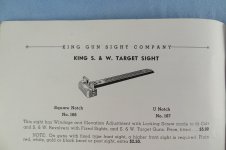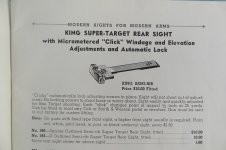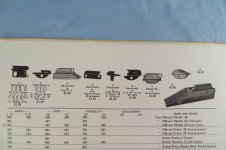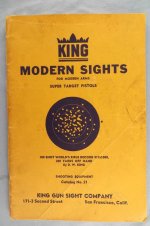bill-in-texas
US Veteran
After looking forwards and backwards through the very informative thread below, I can't find a matching rear sight in any of the catalog scans to the one I have. I've also searched the forum for photographic images of any early-mid 20th century Smiths or Colts having this same rear sight. No luck.
However, it appears to be the same rear sight listed as Design 14, on page 35, depicted as a line drawing in the latest SWCA Journal.
I'd like to see another example affixed to a revolver.
-Anyone got one?
http://smith-wessonforum.com/s-w-ha...information-thread.html?611178=#post140673406
All input is welcome. (Ahem, Mr. Ralph Tremaine?)

Also, the King Modified Patridge front sight on my revolver is marked "Pat. Pend."
Does anyone know approximately how far that dates back, prior to receiving the patent?

Thanks in advance!
-Bill
P.S. I've sent off for a letter to hopefully learn more about this uncommon and unusual .45 Hand Ejector, Model of 1917.

Click Links for More Pictures
https://i.ibb.co/Gdf2Dyd/6-D2-A2-F48-46-CE-4-F8-C-B7-C3-312-BFC5-E3-A97.jpg"
"https://i.ibb.co/qkkvvy9/6-F97-B892-F18-B-4-EFE-83-E8-C56426-B1-C48-B.jpg"
"https://i.ibb.co/0cwt8rL/3-CFA8865-4-E90-4-ECC-BDD8-76-E347-DD42-F9.jpg"
"https://i.ibb.co/866TKJq/97897142-7-A32-458-F-AAF0-23-B2-AD00-CEC1.jpg"
However, it appears to be the same rear sight listed as Design 14, on page 35, depicted as a line drawing in the latest SWCA Journal.
I'd like to see another example affixed to a revolver.
-Anyone got one?
http://smith-wessonforum.com/s-w-ha...information-thread.html?611178=#post140673406
All input is welcome. (Ahem, Mr. Ralph Tremaine?)

Also, the King Modified Patridge front sight on my revolver is marked "Pat. Pend."
Does anyone know approximately how far that dates back, prior to receiving the patent?

Thanks in advance!
-Bill
P.S. I've sent off for a letter to hopefully learn more about this uncommon and unusual .45 Hand Ejector, Model of 1917.

Click Links for More Pictures
https://i.ibb.co/Gdf2Dyd/6-D2-A2-F48-46-CE-4-F8-C-B7-C3-312-BFC5-E3-A97.jpg"
"https://i.ibb.co/qkkvvy9/6-F97-B892-F18-B-4-EFE-83-E8-C56426-B1-C48-B.jpg"
"https://i.ibb.co/0cwt8rL/3-CFA8865-4-E90-4-ECC-BDD8-76-E347-DD42-F9.jpg"
"https://i.ibb.co/866TKJq/97897142-7-A32-458-F-AAF0-23-B2-AD00-CEC1.jpg"
Last edited:






